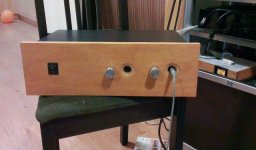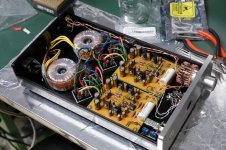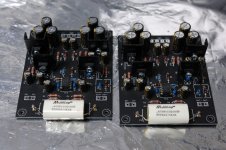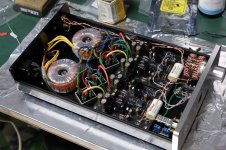I finished up the front plate on my sapphire/J-Mo combo today. Nothing really changed inside the box except that I tweaked the shunt a little and mounted the heatsink for the shunt outside the box just for a little thermal management.
The chassis came from an old marantz cassette deck that had gone to the great tape tangle in the sky and the front is a bit of aformosia (I think). I like timber fronts on equipment. It still looks DIY but is very presentable and I find it easy to do. I can flick the source between the 2 headphone amps with a switch at the back. If having it at the back is an issue I can remount it at the front. But you can only listen to one set of cans at a time and my tendancy is to spend time with the k701 and then flick back to the HD650 for a while... so direct switching isn't all that big a deal I think.
One bad thing did happen - one of the gigawork pots was a bit gammy to start with, and when I tightened it up to the front plate it wouldn't work right at all. I think that there must be a cold joint in there somewhere as sometimes it would work if you squeezed it a certain way etc. Anyway, I stuck an alps rk27 in there until some new pots arrive from ebay. Not exactly the last word in transparency, but it will do for now.
Poor enough pic, but it gives the idea.
Fran
The chassis came from an old marantz cassette deck that had gone to the great tape tangle in the sky and the front is a bit of aformosia (I think). I like timber fronts on equipment. It still looks DIY but is very presentable and I find it easy to do. I can flick the source between the 2 headphone amps with a switch at the back. If having it at the back is an issue I can remount it at the front. But you can only listen to one set of cans at a time and my tendancy is to spend time with the k701 and then flick back to the HD650 for a while... so direct switching isn't all that big a deal I think.
One bad thing did happen - one of the gigawork pots was a bit gammy to start with, and when I tightened it up to the front plate it wouldn't work right at all. I think that there must be a cold joint in there somewhere as sometimes it would work if you squeezed it a certain way etc. Anyway, I stuck an alps rk27 in there until some new pots arrive from ebay. Not exactly the last word in transparency, but it will do for now.
Poor enough pic, but it gives the idea.
Fran
Attachments
That looks really nice Fran. Are you left handed? I have to say I prefer the volume control to the right of the headphone jack, so the cord doesn't block my hand as I adjust the volume.
The other thought I had was re. the selection switch. Really there's little need to have a switch. The line input can drive both volume pots full time, the only penalty is halving the input impedance seen by the source. If that's going to be acceptable you can just connect the input to both pots in parallel, bypassing the switch.
***
@stratus46
Thanks for the link. It's an interesting concept, and I've seen it (or variants) advertised in some few commercial circuits. I'm basically skeptical, based on the old audio axiom "there is no such thing as a free lunch". Adjusting the bias on the fly like that has got to have downsides, though -other than the complexity- they are not immediately obvious to me. I'll look into it though...
Generally speaking for a headphone amp there's no particular advantage to doing it as it is trivial (and costs little) to set the bias such that the output stage runs in class A under any realistic output. i.e. 100 mA or more if you decide that that's what you want. It's just a couple of watts.
The other thought I had was re. the selection switch. Really there's little need to have a switch. The line input can drive both volume pots full time, the only penalty is halving the input impedance seen by the source. If that's going to be acceptable you can just connect the input to both pots in parallel, bypassing the switch.
***
@stratus46
Thanks for the link. It's an interesting concept, and I've seen it (or variants) advertised in some few commercial circuits. I'm basically skeptical, based on the old audio axiom "there is no such thing as a free lunch". Adjusting the bias on the fly like that has got to have downsides, though -other than the complexity- they are not immediately obvious to me. I'll look into it though...
Generally speaking for a headphone amp there's no particular advantage to doing it as it is trivial (and costs little) to set the bias such that the output stage runs in class A under any realistic output. i.e. 100 mA or more if you decide that that's what you want. It's just a couple of watts.
There will be 9 sets of boards available, and will do a limited edition kit if the interest is there.
Hi RJM,
I am interested in a pair of boards if you start a group ordering.
Cheers,
Jacques
Version two up and running on the bench, transplanted into my original Sapphire chassis. As expected my simulation of the bias currents was a bit off. R9,10 should be reduced from the 10 ohms originally specified (giving 230 mA) to something around 6 ohms (100 mA predicted). At 5 ohms I'm getting 70+/-5 mA through the output transistors, stable.
Photos and listening impressions to follow.
Photos and listening impressions to follow.
Hi Fran, I was just about to email you on this subject. The downside of the transplant is the old version is no longer available for me to compare to, so I was planning on hitting you up for your evaluation of 14s1.
The circuit sounds a bit "gummy" for the first 2-3 days until the electrolytic capacitors shake themselves out. So my impressions of 20f will have to wait until the weekend.
While the 14s1 boards can be modified, it is not trivial: you'd have to cut traces on both the top and bottom of the boards, and wire resistors between pads to connect over the cut traces. If you are up for it I can show you what and where.
The circuit sounds a bit "gummy" for the first 2-3 days until the electrolytic capacitors shake themselves out. So my impressions of 20f will have to wait until the weekend.
While the 14s1 boards can be modified, it is not trivial: you'd have to cut traces on both the top and bottom of the boards, and wire resistors between pads to connect over the cut traces. If you are up for it I can show you what and where.
Yeah, I'm up for it.
One of the things though is that I had hoped to get some time to evaluate some different power supplies, play with different transformers and so on. As it stands right now, the sapphire sounds very clean, sounds good with both high and low impedance cans, has no faults to speak of. Against the best I have heard - it probably has a narrower soundstage (if that makes any sense in headphone amps) and a shade less decay/detail. IME, these tend to be the kind of things that power supply improvements bring about. For example, its the kind of thing that I would have heard with the various versions of the phonoclone upto the x-reg version, or between an alps blue and a stepped gigawork pot. In other words - the physical build and off-kit components could make quite the difference here.
Does that make any sense?
Fran
One of the things though is that I had hoped to get some time to evaluate some different power supplies, play with different transformers and so on. As it stands right now, the sapphire sounds very clean, sounds good with both high and low impedance cans, has no faults to speak of. Against the best I have heard - it probably has a narrower soundstage (if that makes any sense in headphone amps) and a shade less decay/detail. IME, these tend to be the kind of things that power supply improvements bring about. For example, its the kind of thing that I would have heard with the various versions of the phonoclone upto the x-reg version, or between an alps blue and a stepped gigawork pot. In other words - the physical build and off-kit components could make quite the difference here.
Does that make any sense?
Fran
Various changes to the "off board" can make substantial improvements, but they tend not to alter the character of the circuit.
Here's how it was for me: I really fell hard for the Sapphire "sound", especially (or more correctly specifically) when connected to a high-end source. The resolution and dynamic energy was phenomenally better than anything I'd yet tried. It could power though even the most intense orchestral music with perfect control. But, if I had to cite a weakness sometimes I could detect a slight "slip" on transients. A tiny moment of distortion on the attack, an excess of emphasis. I wondered maybe it was running out of class A headroom, or perhaps it was simple overshoot. Certainly various improvements I made along the way (higher current, ceramic byapss caps, Zobel) seemed to smooth things over, but I could not say that it (the slip) was completely, 100% eliminated. And it could even be said to be a part of what made the Sapphire sound so good, so lifelike: the transients seemed to have real kick to them that I've only ever heard reproduced before on very, very expensive gear.
This prompted me to look into increasing the bias currents to the practical maximum:
In a nutshell, the modified output stage redistributes the current, reducing the bias in the driving pair by 3 times, and increasing the bias in the output pair 3 times. Overall power consumption / heat dissipation increases only slightly.
Here's how it was for me: I really fell hard for the Sapphire "sound", especially (or more correctly specifically) when connected to a high-end source. The resolution and dynamic energy was phenomenally better than anything I'd yet tried. It could power though even the most intense orchestral music with perfect control. But, if I had to cite a weakness sometimes I could detect a slight "slip" on transients. A tiny moment of distortion on the attack, an excess of emphasis. I wondered maybe it was running out of class A headroom, or perhaps it was simple overshoot. Certainly various improvements I made along the way (higher current, ceramic byapss caps, Zobel) seemed to smooth things over, but I could not say that it (the slip) was completely, 100% eliminated. And it could even be said to be a part of what made the Sapphire sound so good, so lifelike: the transients seemed to have real kick to them that I've only ever heard reproduced before on very, very expensive gear.
This prompted me to look into increasing the bias currents to the practical maximum:
In a nutshell, the modified output stage redistributes the current, reducing the bias in the driving pair by 3 times, and increasing the bias in the output pair 3 times. Overall power consumption / heat dissipation increases only slightly.
Ok, listening impressions: (2.0f / 70 mA / 5 ohms) HD-600
If the previous versions can be described to various degrees as "edgy" then 2.0f would best be described as "edge-less". Round, as in there is no special accentuation of dynamic accents. Thus, in direct comparison with the old version - from memory - the overall presentation is rather unassuming. I found myself gradually warming to it though, noticing a gradual increase in clarity as the break-in time increased.
(I was surprised that the sound changed so much over the week ... the coupling cap an op amp were recycled, so it was only the electrolytics. It was really turgid/sticky/chesty for quite some time, before things started to improve bit by bit.)
The measured noise floor is obscured by some hash from the computer power supply. Ok, it is still down below -120 dB, but I've seen better with the old version so I need to have another look at whether the new GND pad is better or worse than grounding the chassis through the IN- or OUT- pads. The other point is that the bias current in the new version is tuneable, so I would like to try a couple of different settings to see what the audible differences are. Finally, the amp is still in the break-in phase. So the last word on the clarity or lack thereof will have to be deferred.
Rev 2.0f has no obvious audible "gotchas". Its quite a bit different from the old version, which had a definite characteristic of a slight skittishness - resulting in a very percussive, attention-grabbing dynamic performance. 2.0 is languid, smoother and heavier, careful and even-handed. No hint of distortion. If I was forced to frame it as a negative, well, sometimes I find it a bit too polite.
It's good though, really good. Nice control, right into the infrasonic. Treble is tight, never spashy. Plenty of warmth to the midrange, and detail and resolution to spare. I just want one more helping of clarity, an extra step down in the perceived noise floor, so I can truly see into furthest recesses of the recordings. Then it will be perfect.
If the previous versions can be described to various degrees as "edgy" then 2.0f would best be described as "edge-less". Round, as in there is no special accentuation of dynamic accents. Thus, in direct comparison with the old version - from memory - the overall presentation is rather unassuming. I found myself gradually warming to it though, noticing a gradual increase in clarity as the break-in time increased.
(I was surprised that the sound changed so much over the week ... the coupling cap an op amp were recycled, so it was only the electrolytics. It was really turgid/sticky/chesty for quite some time, before things started to improve bit by bit.)
The measured noise floor is obscured by some hash from the computer power supply. Ok, it is still down below -120 dB, but I've seen better with the old version so I need to have another look at whether the new GND pad is better or worse than grounding the chassis through the IN- or OUT- pads. The other point is that the bias current in the new version is tuneable, so I would like to try a couple of different settings to see what the audible differences are. Finally, the amp is still in the break-in phase. So the last word on the clarity or lack thereof will have to be deferred.
Rev 2.0f has no obvious audible "gotchas". Its quite a bit different from the old version, which had a definite characteristic of a slight skittishness - resulting in a very percussive, attention-grabbing dynamic performance. 2.0 is languid, smoother and heavier, careful and even-handed. No hint of distortion. If I was forced to frame it as a negative, well, sometimes I find it a bit too polite.
It's good though, really good. Nice control, right into the infrasonic. Treble is tight, never spashy. Plenty of warmth to the midrange, and detail and resolution to spare. I just want one more helping of clarity, an extra step down in the perceived noise floor, so I can truly see into furthest recesses of the recordings. Then it will be perfect.
- Home
- Amplifiers
- Headphone Systems
- RJM Audio Sapphire Desktop Headphone Amplifier




